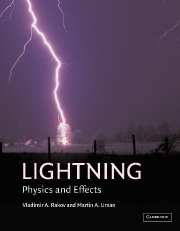Book contents
- Frontmatter
- Contents
- Preface
- 1 Introduction
- 2 Incidence of lightning
- 3 Electrical structure of lightning-producing clouds
- 4 Downward negative lightning discharges to ground
- 5 Positive and bipolar lightning discharges to ground
- 6 Upward lightning initiated by ground-based objects
- 7 Artificial initiation (triggering) of lightning by ground-based activity
- 8 Winter lightning in Japan
- 9 Cloud discharges
- 10 Lightning and airborne vehicles
- 11 Thunder
- 12 Modeling of lightning processes
- 13 The distant lightning electromagnetic environment: atmospherics, Schumann resonances, and whistlers
- 14 Lightning effects in the middle and upper atmosphere
- 15 Lightning effects on the chemistry of the atmosphere
- 16 Extraterrestrial lightning
- 17 Lightning locating systems
- 18 Deleterious effects of lightning and protective techniques
- 19 Lightning hazards to humans and animals
- 20 Ball lightning, bead lightning, and other unusual discharges
- Appendix: Books on lightning and related subjects
- Index
1 - Introduction
Published online by Cambridge University Press: 05 June 2013
- Frontmatter
- Contents
- Preface
- 1 Introduction
- 2 Incidence of lightning
- 3 Electrical structure of lightning-producing clouds
- 4 Downward negative lightning discharges to ground
- 5 Positive and bipolar lightning discharges to ground
- 6 Upward lightning initiated by ground-based objects
- 7 Artificial initiation (triggering) of lightning by ground-based activity
- 8 Winter lightning in Japan
- 9 Cloud discharges
- 10 Lightning and airborne vehicles
- 11 Thunder
- 12 Modeling of lightning processes
- 13 The distant lightning electromagnetic environment: atmospherics, Schumann resonances, and whistlers
- 14 Lightning effects in the middle and upper atmosphere
- 15 Lightning effects on the chemistry of the atmosphere
- 16 Extraterrestrial lightning
- 17 Lightning locating systems
- 18 Deleterious effects of lightning and protective techniques
- 19 Lightning hazards to humans and animals
- 20 Ball lightning, bead lightning, and other unusual discharges
- Appendix: Books on lightning and related subjects
- Index
Summary
An electrically active thundercloud may be regarded as an electrostatic generator suspended in an atmosphere of low electrical conductivity. It is situated between two concentric conductors, namely, the surface of the earth and the electrosphere, the latter being the highly conducting layers of the atmosphere at altitudes above 50 to 60 km.
D.J. Malan (1967)In this chapter, we introduce the basic lightning terminology (Section 1.2) and summarize the available quantitative information on various aspects of lightning in tabular form (Section 1.3). Additionally, we give a historical overview of the mythology and science of lightning covering the period from ancient times to the mid twentieth century (Section 1.1) and briefly discuss the global electric circuit that is generally thought to be energized by thunderstorms (Section 1.4). Finally, we consider whether the energy of lightning can be utilized and show that this is impractical (Section 1.5).
Historical overview
It is likely that lightning was present on Earth long before life evolved on our planet about three billion years ago. Further, it is possible that lightning played a role in producing the organic molecules necessary for the formation of every life form (Oparin 1938; Section 15.9 of this book). Harland and Hacker (1966) reported on a fossil glassy tube, referred to as a fulgurite, created by lightning 250 million years ago. Encounters of early humans with lightning undoubtedly were frightening and fascinating.
- Type
- Chapter
- Information
- LightningPhysics and Effects, pp. 1 - 23Publisher: Cambridge University PressPrint publication year: 2003
- 2
- Cited by



